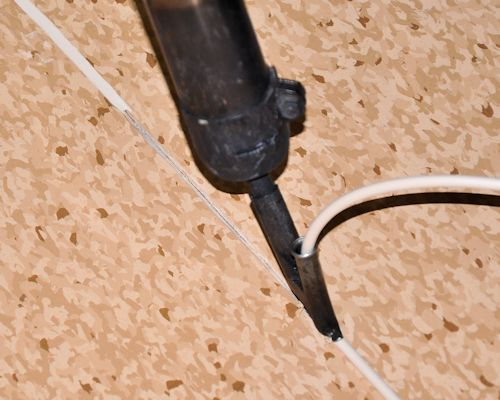
Thermal welding is very popular and is usually used in vinyl sheets for laboratory, clean room, and medical environment applications.
Thermal welding forms a hot-melt bond between the two vinyl floors, providing a complete joint and preventing contaminants and local moisture from migrating into the joint. In vinyl board applications in laboratories, clean rooms, and medical environments, thermal welding is very popular and often required.
Thermal welding forms a hot-melt bond between the two vinyl floors, providing a complete joint and preventing contaminants and local moisture from migrating into the joint.
Vinyl flooring should be installed in accordance with the manufacturer's instructions, including the proper use of adhesives. Before starting the soldering process, the adhesive should be allowed to dry. The waiting time depends on the type of adhesive used.
Similar to how you use a piece of scrap to ensure that the groove scribe is set at the proper distance before scoring, it is a good practice to take a piece of scrap and practice to reach the proper depth and width. Slot before starting to sew.
The goal of thermal welding is to form a three-point weld to obtain the best bonding strength with the electrode. This three-point welding is formed at the edge of the two pieces of material and the bottom of the groove channel.
There are two methods for grooving the seams: manual grooving and power grooving. Each item requires at least manual grooving so that it can be grooved close to the wall and welding intersection. There are many types of manual slotting machines to choose from; choose a product that makes you feel comfortable and easy to control. Power slotting machines are used for large projects and long seams, where tool efficiency can bring benefits. When used correctly on a flat floor, they provide consistent groove depth and width.
The depth of the grooves at the seams of the homogeneous vinyl board should be 2/3 of the thickness of the material. The groove should be in the center of the seam, and the same amount of vinyl (50/50) should be removed from the two pieces of material. This is important because if you remove unequal amounts of welding rods, the final bonding of the welding rods may be affected.
To avoid contamination of the joint area before thermal welding, I recommend that you do not make grooves at the joint until you are ready to weld. Other industries and simple foot traffic may bring dirt and debris into the grooves and hinder good welding.
Like manual and electric slotting machines, there are a variety of hot welding guns available on the market. They differ in several aspects of cost and performance. Be cautious when choosing the right heat torch for you and the type of material you weld on a regular basis-vinyl, linoleum, and rubber. Hand-held and automatic self-propelled, digital and manual heating settings, temperature range, etc.
It is important to choose the right welding tip for the hot welding gun. Consult with floor manufacturers to determine if they have a preference based on surface PUR. When using a 4mm welding rod, please use a 4mm welding tip. The tip that provides a narrow air flow will keep the hot air on the groove and help prevent the wider heat flow from tilting down the seam.
The temperature setting on the heat gun may be affected by the power source, the length of the extension cord, the temperature of the substrate, the temperature of the ambient air, and the speed at which the installer moves along the seam.
As with scoring and grooving, it is recommended to use a piece of scrap to construct the practice seam to ensure that the heat setting and speed of the installer's work will provide a good seam.
When welding, you should see the "cleaning" on both sides of the electrode at the floor contact point. This cleaning indicates that you are making the electrode melt and bond to the floor material correctly.
Scraping the electrode is a two-step process. After welding, most of the welding rod should be removed immediately with a scraper and trimming plate for the first pass. Allow the electrode to cool to room temperature, which usually takes about 20 to 30 minutes.
After welding, most of the welding rod should be removed immediately with a scraper and trimming plate for the first pass.
After the electrode is cooled to room temperature, use a spatula to perform the second or final pass.
The floor can be opened to traffic immediately after the heat welding process is completed. Hot welding is not a difficult process, but these steps must be followed to make the welding successful. I recommend a lot of practice, which will increase your efficiency and make you a prolific heat welder.
